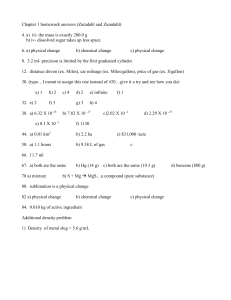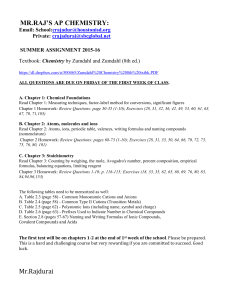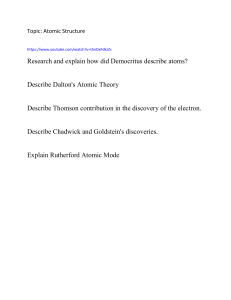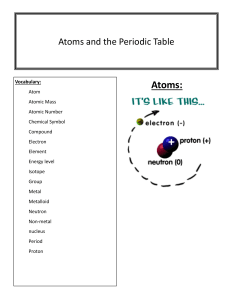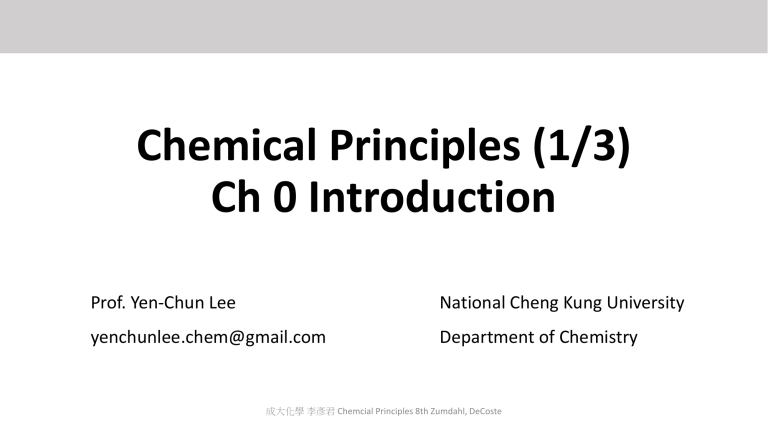
Chemical Principles (1/3) Ch 0 Introduction Prof. Yen-Chun Lee National Cheng Kung University yenchunlee.chem@gmail.com Department of Chemistry 成大化學 李彥君 Chemcial Principles 8th Zumdahl, DeCoste Syllabus Textbook: Chemical Principles 8th Edition Steven S. Zumdahl, Donald J. DeCoste Instructors: 1.李彥君 (9/05-10/17) 2.蔡惠蓮 (10/20-11/24) 3.邱顯泰 (11/28-1/02) Evaluation: The score will be given by three instructors 10% Attendance (1-3 times) 90% Midterm Exam (10/17 Ch2-Ch4) 成大化學 李彥君 Chemcial Principles 8th Zumdahl, DeCoste Syllabus Textbook: Chemical Principles 8th Edition Steven S. Zumdahl, Donald J. DeCoste Instructors: 1.李彥君 (9/05-10/17) 2.蔡惠蓮 (10/20-11/24) 3.邱顯泰 (11/28-1/02) Chapter & Aim: 2. Atoms, Molecules, and Ions 3. Stoichiometry 4. Types of Chemical Reactions and Solution Stoichiometry 成大化學 李彥君 Chemcial Principles 8th Zumdahl, DeCoste Syllabus Textbook: Chemical Principles 8th Edition Steven S. Zumdahl, Donald J. DeCoste Instructors: 週期 一 二 1.李彥君 (9/05-10/17) 2.蔡惠蓮 (10/20-11/24) 三 3.邱顯泰 (11/28-1/02) 四 Chapter & Aim: 2. Atoms, Molecules, and Ions 五 3. Stoichiometry 六 4. Types of Chemical Reactions and Solution 七 Stoichiometry 成大化學 李彥君 Chemcial Principles 8th Zumdahl, DeCoste 星期 日期 課程進度 一 09/05 Chapter 2-1 三 09/08 Chapter 2-2 一 09/12 Chapter 2-3 三 09/15 Chapter 3-1 一 09/19 Chapter 3-2 三 09/22 Chapter 3-3 一 09/26 Chapter 4-1 三 9/29 放假 一 10/03 Chapter 4-2 三 10/06 Chapter 4-3 一 10/10 放假 三 10/13 Chapter 4-4 一 10/17 Midterm Exam 1 Chemical Principles (1/3) Ch 2-1 Atoms, Molecules, and Ions Prof. Yen-Chun Lee National Cheng Kung University yenchunlee.chem@gmail.com Department of Chemistry 成大化學 李彥君 Chemcial Principles 8th Zumdahl, DeCoste Ch 2-1 Atoms, Molecules, and Ions 2.1 The Early History of Chemistry 2.2 Fundamental Chemical Laws 2.3 Dalton’s Atomic Theory 2.4 Cannizzaro’s Interpretation 2.5 Early Experiments to Characterize the Atom 2.6 The Modern View of Atomic Structure 2.7 Molecules and Ions 2.8 An Introduction to the Periodic Table 2.9 Naming Simple Compounds DOI: 10.1126/science.aab1576 Cryo-Electron Microscopy: (2.2 Å ) the average resolution of a cryo-EM structure has improved from 15 Å to 6 Å. angstrom • angstrom • 1 Å =10 nm = 10−10 m • Hydrogen atom = 0.5 Å 成大化學 李彥君 Chemcial Principles 8th Zumdahl, DeCoste Ch 2.1 The Early History of Chemistry Curiosity: the problems of philosophy How do you define existence? René Descartes: I think, therefore I am. What is the origin of life? 1. The fundamental form of life a property of a group of molecules composed of chiral units (enantiomers) 2. The origin of biological homochirality 3. The origin of organic molecules What are the fundamental substances that compose all matter? By about 400 b.c. the Greeks had proposed that all matter was composed of four fundamental substances: fire, earth, water, and air. 成大化學 李彥君 Chemcial Principles 8th Zumdahl, DeCoste Ch 2.1 The Early History of Chemistry What are the fundamental substances that compose all matter? • By about 400 b.c. the Greeks had proposed that all matter was composed of four fundamental substances: Fire, earth, water, and air. • Democritus (德謨克利特) used the term atomos (Atoms) to describe the ultimate particles, which are continues and infinitely divisible. 成大化學 李彥君 Chemcial Principles 8th Zumdahl, DeCoste Ch 2.1 The Early History of Chemistry Discovery of oxygen Phlogiston theory: • Georg Stahl (1660–1734) suggested that a substance he a nonexistenet chemical that, prior to the discovery of oxygen, was thought to be released during combustion. (colorless, odorless and tasteless) called phlogiston flowed out of the burning material. • A substance burning in a closed container eventually stopped burning because the air in the container became saturated with phlogiston. Oxygen gas: dephlogisticated air • Discovered by Joseph Priestley • It supports vigorous combustion and supposed to be low in phlogiston. What happens doesn’t change, but our ideas about why a phenomenon occurs can change 成大化學 李彥君 Chemcial Principles 8th Zumdahl, DeCoste Ch 2.2 Fundamental Chemical Laws Discoveries based on mass changes Law of conservation of mass: • Antoine Lavoisier weighed the reactants and products of various reactions. • Mass is neither created nor destroyed. Law of definite proportion • Joseph Proust showed that a given compound always contains exactly the same proportion of elements by mass. • The substance copper carbonate (CuCO3) is always 5.3 parts copper to 4 parts oxygen to 1 part carbon (by mass). → 成大化學 李彥君 Chemcial Principles 8th Zumdahl, DeCoste Ch 2.2 Fundamental Chemical Laws • Discoveries based on mass changes John Dalton reasoned that if elements were composed of tiny individual particles, a given compound should always contain the same combination of these atoms. Law of multiple proportions • When two elements form a series of compounds, the ratios of the masses of the second element that combine with 1 gram of the first element can always be reduced to small whole numbers. 成大化學 李彥君 Chemcial Principles 8th Zumdahl, DeCoste Ch 2.2 Fundamental Chemical Laws Exercise-1 Please provide me the nitrogen mass ratios between compound I, II, III. For compound I to III, if we fix the mass of oxygen, the mass ratio of nitrogen is 4:2:1. Dalton could not deduce absolute formulas from the available data on relative masses. 成大化學 李彥君 Chemcial Principles 8th Zumdahl, DeCoste Ch 2.3 Dalton’s Atomic Theory 1. Each element is made up of tiny particles called atoms. 2. The atoms of a given element are identical; the atoms of different elements are different in some fundamental way or ways. 3. Chemical compounds are formed when atoms combine with one another. A given compound always has the same relative numbers and types of atoms. 4. Chemical reactions involve reorganization of the atoms— changes in the way they are bound together. The atoms themselves are not changed in a chemical reaction. 成大化學 李彥君 Chemcial Principles 8th Zumdahl, DeCoste Atoms Compounds Reactions Ch 2.3 Dalton’s Atomic Theory Experimental results: water was known to be composed of the elements, hydrogen and oxygen, with 8 grams of oxygen present for every 1 gram of hydrogen. • Formula of water was unknown. • Dalton made a fundamental assumption: He assigned hydrogen a mass of 1 and oxygen a mass of 8. • First table of atomic masses • Many of the masses were later proved to be wrong because of Dalton’s incorrect assumptions about the formulas of certain compounds, but the construction of a table of masses was an important step forward. 成大化學 李彥君 Chemcial Principles 8th Zumdahl, DeCoste Ch 2.3 Dalton’s Atomic Theory How were the absolute formulas for compounds determined? Avogadro’s hypothesis (law): Amedeo Avogadro proposed that equal volumes of gases under the same conditions of temperature and pressure will contain equal numbers of molecules. Joseph Gay-Lussac’s experimental outcomes: 2 volumes of hydrogen react with 1 volume of oxygen to form 2 volumes of gaseous water . Result: • Explain that gaseous oxygen is composed of diatomic (two-atom) molecules. • Suggest the formula for water is H2O, not OH as Dalton believed. 成大化學 李彥君 Chemcial Principles 8th Zumdahl, DeCoste Ch 2.4 Cannizzaro’s Interpretation How did Cannizzaro put together a common set of atomic masses? Two main beliefs: 1. Compounds contained whole numbers of atoms as Dalton postulated. 2. Avogadro’s hypothesis was correct—equal volumes of gases under the same conditions contain the same number of molecules. Approach: • comparing the mass of 1 liter of a given gas with the mass of 1 liter of hydrogen gas • At the same temperature and pressure, two gases have same number of molecules The relative atomic masses for oxygen and hydrogen are 16 and 1. (diatomic molecules) 成大化學 李彥君 Chemcial Principles 8th Zumdahl, DeCoste Ch 2.4 Cannizzaro’s Interpretation How did Cannizzaro put together a common set of atomic masses? Cannizzaro’s experiment: Oxygen reacts with carbon to form carbon dioxide: • Chemical analysis of carbon dioxide had shown it to contain 27% carbon (by mass) • Cannizzaro found the relative molecular mass of carbon dioxide to be 44 (relative to 2 for H2) • What can we conclude based on this information? ----12 g of carbon in 44 g of carbon dioxide and 32 g of oxygen. ----We cannot confirm the relative mass of carbon dioxide without knowing the formula. Cannizzaro addressed this problem by obtaining the relative molecular masses of many other compounds containing carbon. 成大化學 李彥君 Chemcial Principles 8th Zumdahl, DeCoste Ch 2.4 Cannizzaro’s Interpretation How did Cannizzaro put together a common set of atomic masses? The relative mass of carbon present in the compounds is always a multiple of 12. 1. Relative mass of carbon is 12. 2. the formula for carbon dioxide is CO2. 成大化學 李彥君 Chemcial Principles 8th Zumdahl, DeCoste Ch 2.4 Cannizzaro’s Interpretation How did Cannizzaro put together a common set of atomic masses? Note that Cannizzaro’s work led to approximate values of the relative atomic masses. His goal was not to determine highly precise values for atomic masses but rather to pin down the approximate values. The relative mass of carbon present in the compounds is always a multiple of 12. 1. Relative mass of carbon is 12. 2. the formula for carbon dioxide is CO2. 成大化學 李彥君 Chemcial Principles 8th Zumdahl, DeCoste Ch 2.4 Cannizzaro’s Interpretation How did Cannizzaro put together a common set of atomic masses? 道爾吞原子說:原子不可分割。但他不知道分子的組成,假設錯水的分子式。 亞佛加厥假說:在定溫定壓下,氣體分子數目與體積成正比。 給呂薩克證明:以前述假說為基礎,進行氫氣與氧氣燃燒得到水氣。 提供水H2O之分子式有利的證據。 坎尼扎羅:整理一系列含碳分子中碳原子的重量,澄清的原子量及分子量的概念。 The relative mass of carbon present in the compounds is always a multiple of 12. 1. Relative mass of carbon is 12. 2. the formula for carbon dioxide is CO2. 成大化學 李彥君 Chemcial Principles 8th Zumdahl, DeCoste
